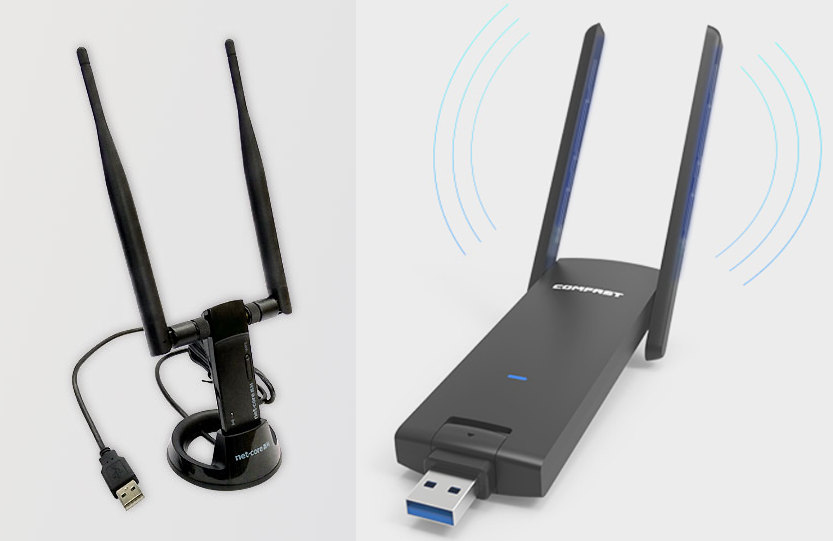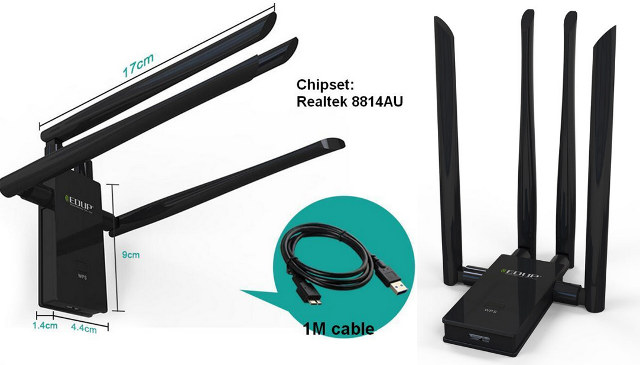When last week I reviewed Rock64 board I noticed they sold a “USB 3.0 Dual Band 1200Mbps WIFI 802.11 a/b/g/n/ac (RTL8812AU) adapter” for $19.99. So far I had only seen USB dongles with internal antennas or a single external antenna, but in the case of development boards, which may be used as routers or gateways, it makes perfect sense to get such adapter for higher performance and longer range. The only problem is that it “ships together with ROCK64 fulfillment”, meaning you can’t purchase it separately if you already have some other board to use, so I went to look for alternatives.

One of the first I’ve come across was COMFAST CF-926AC with the following specifications:
- Chipset – Mediatek MT7612U
- Interface – USB 3.0 rotatable port
- WiFi – Dual band 2T2R WiFi 802.11ac, 802.11a, 802.11b, 802.11g, 802.11n up to “1200” Mbps (867 Mbps @ 5.8 GHz + 300 Mbps @ 2.4 GHz)
- Antenna – 2x external high gain (3dBi) antennas (270° rotation)
- Dimensions – 19.50 x 5.00 x 1.40 cm
- Weight – 410 grams
The page description mentions it works without drivers on Windows, but one seller reports that “it can support win10 system receive wifi signal,but it can’t support win10 system emission wifi signal”. As usual, no mention of Linux, but luckily a quick search found MT7612U Linux driver with support for AP and STA mode, just don’t run iwconfig in AP mode… It requires Linux 4.2 or greater, and as only been tested on x86_64 so far, so your mileage may vary on other targets.
I first found it on Aliexpress for $16.99 shipped, but you’ll also find it on GearBest for $15.99, and Amazon US for $19.99.

During my search I also found EDUP EP-AC1621 USB 3.0 WiFi adapter with four external antennas and the following specifications:
- Chipset – Realtek RTL8814AU
- Interface – USB 3.0 OTG port
- WiFi – Dual band WiFi 802.11ac, 802.11a, 802.11b, 802.11g, 802.11n up to 1900 Mbps (1300 Mbps @ 5.8 GHz + 600 Mbps @ 2.4 GHz)
- Antenna – 4x external high gain (6dBi) antennas
- Misc – WPS key
- Dimensions – 9.0 x 4.4 x 1.4 cm (body); 17 cm long antennas
The device does not connect directly to the USB port, but instead via a one meter USB 3.0 OTG to USB 3.0 type A cable. The description explains it comes with an “easy to use CD setup wizard and compatible with Microsoft Windows XP/VISTA/Win7/8.1/10 Linux/Macintosh”. In case, you’d rather have an alternative driver, you’ll find an 8814AU Linux driver in Github based on the original driver for Linux kernels up to 4.8 with DKMS support, but there are some commits to make it work with newer kernels.
I found that model on Aliexpress for $41.90, but again you can also purchase it on Amazon US or GearBest (and other sites).You may learn a little more by visiting the manufacturer’s product page.
Various other models are also sold, the important is to check whether the chipset is supported by your operating system, and if it supports the modes (AP, STA, AP+STA) required for your use case. Those type of adapters only really make sense with boards and devices with USB 3.0 interfaces, since USB 2.0 is limited to 480 Mbps.

Jean-Luc started CNX Software in 2010 as a part-time endeavor, before quitting his job as a software engineering manager, and starting to write daily news, and reviews full time later in 2011.
Support CNX Software! Donate via cryptocurrencies, become a Patron on Patreon, or purchase goods on Amazon or Aliexpress





Well, dealing with those Wi-Fi dongles means dealing with misleading numbers (or let’s call it marketing BS for now). Vendors only advertise PHY data rates eg. ‘867 Mbps @ 5.8 GHz + 300 Mbps @ 2.4 GHz’. Adding those to something like “1200 Mbps” is pure marketing BS since normally you use either 2.4 or 5GHz band. Then wireless PHY data rates do not relate with data transfer bandwidth that much (without frame aggregation for example a 433Mbps PHY rate means 50.4 Mbps maximum UDP data rate under ideal conditions which do not exist in the wild. When TCP overhead is added real-world throughput decreases even more).
An USB2 port is good for +30MB/s bandwidth and most probably sufficient for the RTL8814AU too since with 802.11ac you get great performance only if both client and AP feature many antennas and spatial streams and distance is that low that throwing an Ethernet cable is always an option. Though an USB3 port is a better idea due to power requirements (if TX power is adjustable and it’s allowed in your country to increase power).
I’m rather happy with a cheap (less than $15 including shipping here in DE) dual-band/dual-antenna dongle based on RT5572 (only 802.11n capable and either 2.4GHz or 5GHz possible) to escape the overcrowded 2.4GHz band. Performance over larger distances against a good AP is quite nice and much much better compared to 1T1R 2.4Ghz onboard Wi-Fi crap (works out of the box too since rt2800 driver is part of every somewhat decent Linux kernel version)
BTW I personally would never think about using SBC + such a dongle to be used as an AP since every cheap real AP/router with support for *WRT/LEDE will perform better (due to more antennas, features like beamforming and most probably non crippled wireless firmware allowing for more than a few clients and so on)
The drivers all suck.
For RTL8814AU
With my setup I achieve around 39.5MB/s in USB3 mode
EDUP EP-AC1621 Linkssys WRT3200ACM
This device has some “nice” feature, you can switch via software between USB2 or USB3 transfer mode.
With default configuration the driver uses USB2 mode
You have to run
insmod rtl8814au.ko rtw_switch_usb_mode=1
to use USB3
or you can use
https://github.com/ulli-kroll/rtl8814au
as all in one package with v4.12 support
😉
monitor mode??
@hex
For monitor mode (essential for software such as kismet) and packet injection, keep an eye on the web page on
www wirelessshack org / best-kali-linux-compatible-usb-adapter-dongles-2016.html — last updated on June 16, 2017
According to that page, there do not appear to be any 802.11ac usb devices with monitor mode + packet injection which are supported yet on GNU/Linux.
However, the GitHub repository at github com / astsam/rtl8812au claims to provide kernel module monitor mode + packet injection functionality for the RTL8812AU/21AU and RTL8814AU chipsets, the latter being used in the EDUP EP-AC1621 in the article above.
@cnx
I had considered a suggestion to buy a 2.4GHz 2T2R USB WiFi Adapter to extend range of my miniPC WiFi, but a) I have only 1 spare USB port v an unused GbE port, b) I have never seen any proper reviews, and c) Amazon customer reviews generally quite critical – most common unreliable, bad drivers, frequently dropped connections.
Don’t recall any testing the range, – the only point my buying an external range extender – to significantly improve on my internal Intel HM7260HME.
Only one configuration might consider is at end of USB cable least 1m above my desk for best line-of-sight.
Might you consider reviewing a few of the more ‘promising’ models ? One that claims long range is ‘WL-PATRIOT-USB’ with incl 5dBi Ant.& 5m USB Claimed Sens -90dBm @ HT20 (sold by Solwise.co.uk. but seems bit pricy for a 1 trick pony, using a quite old RT3070L) Only mention of data transfer rate is theoretical 150Mbps – which as tkaiser points out, will not be acheivable in real tests. At least Solwise give a fuller spec than most Amazon products.
I remember you suggesting this when answering my post on the Olimex ESP32-GATEWAY Board (I’m interested in ESP32 on account of low consumption, but wasn’t thinking to pick the Olimex, as no Ext Ant). I don’t know if you saw my long reply #35 to your post on the 2 Ext Ant VIM2 – I wrote “I looked in OpenWRT HW Table – a dauntingly v. long list with no way to filter on the criteria of interest: 2.4GHz range & energy consumption. Have you any suggestions on where to hone in on a ‘cheapest 2 or 3 antenna 2.4GHz LEDE/*WRT capable Router’ with consumption <6W ?"
Hello, few months ago I purchased this wifi dongle http://www.gearbest.com/network-cards/pp_449962.html?wid=21
It was cheap so I bought and when I got it I found few issues at first with windows and the driver for linux didn’t work at all even those downloaded from Mediatek website (the chip is based on MT7612U). In windows it worked despite having few connection drops now and then.
Upon further research I found a solution:
First I had to drop the connection bandwidth in my router settings from 80Mhz to 40Mhz to get rid of the connection drops.
Then I had to download updated drivers for Windows from here https://www.netgear.com/support/product/A6210.aspx.
As for linux I had to use the driver from this source https://github.com/jurobystricky/Netgear-A6210.
The Dongle works very good and the connection is very stable, I use it ONLY with the 5Ghz band.
@dx
It is true. The drivers for all these 11AC chips (both Mediatek and Realtek) suck so hard in Linux. And for whatever reason there is zero mainline support. Probably because nobody wants to touch this mess to kick it into reasonable shape for upstreaming.